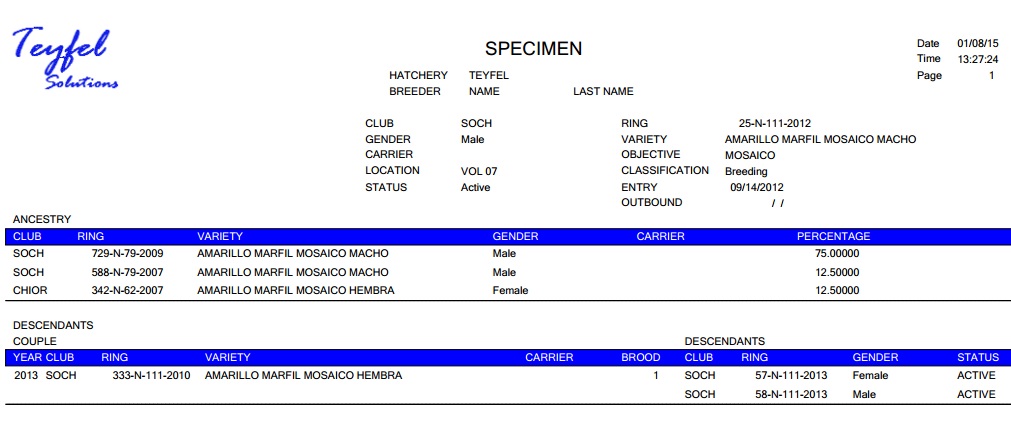Catalog of specimens
In My-Breeding.com you have a complete catalog of specimens, made with specimens acquired as those born in the hatchery. Each specimen has the information needed to manage the specimens.

1. Breeder Club. This is a definition that the breeder should do in My-Breeding.com. Code and Name of the Clubs of which has specimens.
2. Breeder. This is a definition that the breeder should do in My-Breeding.com. Code and Name of the Breeders of which has specimens.
3. Year of birth.
4. Type of ring. The type of ring allows the breeder to have different sequences number of rings per season. This is a definition that the breeder should do in My-Breeding.com.
5. Number of ring. Identification number of the specimen. A breeder may have more than one specimen with the same ring number, as long as his year of birth is different and / or the type of ring is different.
6. Gender. The specimen can be male, female or Undefined (especially in the youngster).
7. Type de specimen. The type of specimen allows the breeder to distinguish different species of birds or separating a species in large groups. As an example, to separate the canaries in color canaries and shape and posture canaries. For each type of specimen, the breeder can parameterize the days of incubation, days to review fertility days for banding.
8. Variety of specimen. The variety of the specimen allows the breeder to differentiate between different races, mutations, etc. within a type specimen.
9. Carrier.This data can specify a feature that carries the specimen (opal, ivory, etc.).
10. Objective of specimen. The objective of the specimen allows the breeder to organize their specimens according to the purpose for which considered.
11. Location. The breeder can define the different locations you have on your hatchery (individual cages, breeding, flight cages, etc.) and the specimen is in one of them.
12. Classification. The classification allows the breeder to separate their specimens in Breeding, Youngster or assignable.
13. Date of entry. The date on which a specimen is acquired or the birth of the specimen for those born in the hatchery.
14. Status. The state of the specimen can be active (belongs to Hatchery) or inactive (no longer belongs to the hatchery or died).
15. Date of outbound. The date on which a specimen was given or the date of his death.
16. Observations. Annotations that the breeder can be done on the specimen.
Each specimen also will accumulate information from their descendants and, therefore, the descendants will accumulate information about their ancestry. My-Breeding.com display this information from the detail of the specimen or ancestry tree.

Ancestry tree:



